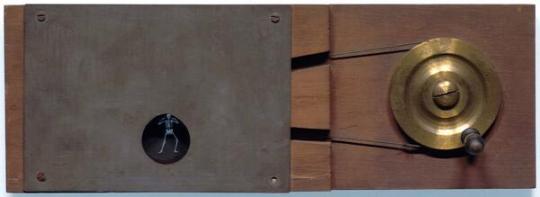We're posting this dancing skeleton today in the spirit of the final day of the Day of the Dead, a Central American multi-day holiday in which celebrants pray for and rejoice in the memory of departed friends and family.
This nimble fellow is the product of a glass disk choreutoscope (ca. 1880?), seen in the image below. The choreutoscope is a form of early animated entertainment that consisted of paper and glass discs mounted at the end of a wood frame. The glass disk has six individual scenes of a skeleton. As you rotated the disk in quick succession, the rapidly flashing images of each individual scene were intended to create the illusion of a dancing figure.

The choreutoscope, much like the closely related cinematograph, was invented in the later 19th century. It was the creation of the British physician Lionel Smith Beale (1828-1906), who invented it in 1866 but never patented his design. This enabled others to make use of his innovation, including the American A. B. Brown in 1869 and the English optician William Charles Hughes (1828-1906) in 1884.
This particular model was made by the firm of T.H. McAllister, which had its roots in the Philadelphia optical business of John McAllister, Sr. (1753-1830). The senior McAllister emigrated to Philadelphia from Scotland around 1775, and established a business selling whips and canes before adding spectacles to his stock in 1796. The company, located on Chestnut Street, remained in operation for the next hundred years, changing names as it passed from generation to generation.
In 1865, Thomas Hamilton McCallister (1824-1898), one of John McAllister's grandchildren, left Philadelphia to start his own optical business in New York City. In 1867, he began manufacturing an inexpensive u2018household microscope' for use by hobbyists. Its popularity led his brother William Young McCallister to begin carrying the microscope in the family's Philadelphia storefront, along with the many other similar models that would spring up in the aftermath of Thomas's design.
In addition to microscopes, Thomas's store, located first on Broadway before relocating to Nassau Street, specialized in magic lanterns and similar items. His choreutoscope was a popular design for manufacturers, due to the fact that Lionel Smith Beale's model also utilized a skeleton motif.
The item is part of Hagley Library's collection of Alexis du Pont stereoviews and lantern slides (Accession 2016.303). The collection has an accompanying digital collection that also includes non-mechanical lantern slides, stereoviews, an astronomical rackwork slide, single and double slip slides, and slip panorama slides. Animated video files accompany these items to demonstrate them in use.
To view these items now in our Digital Archive, click here.


